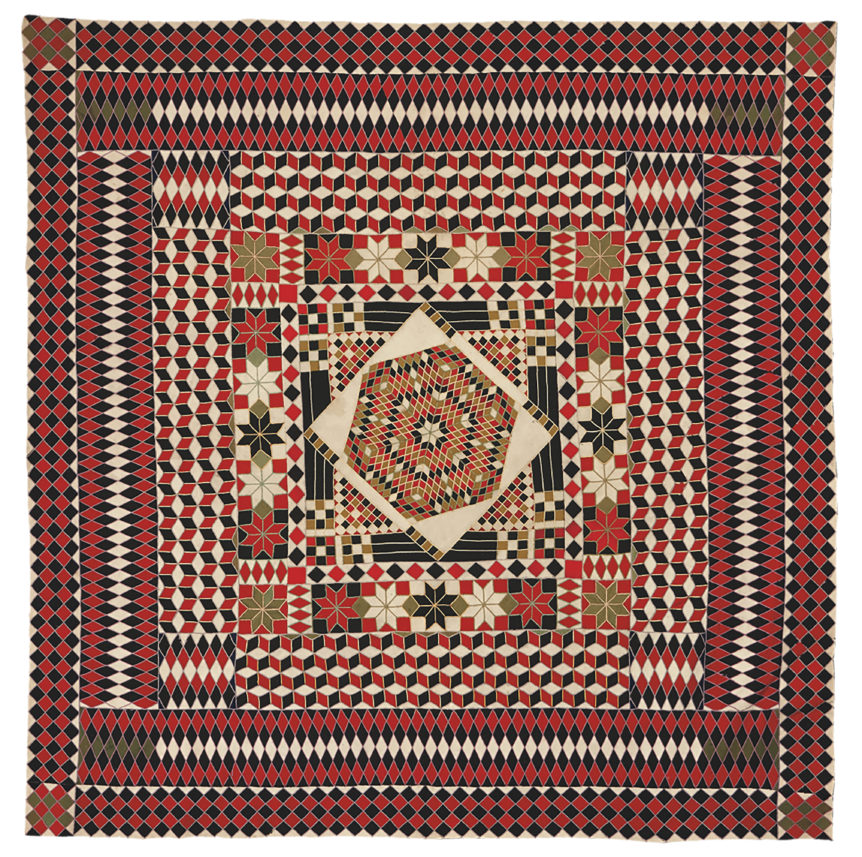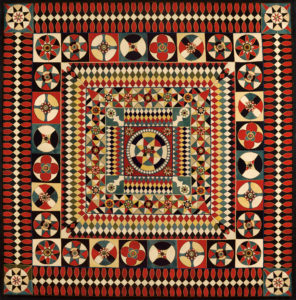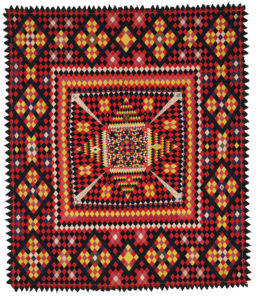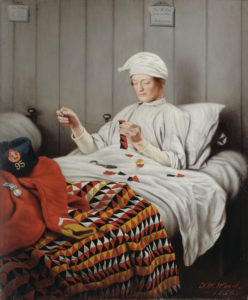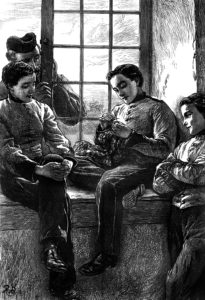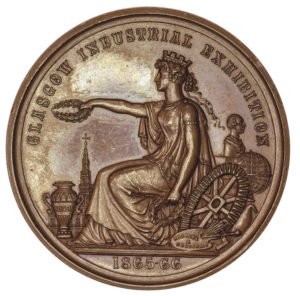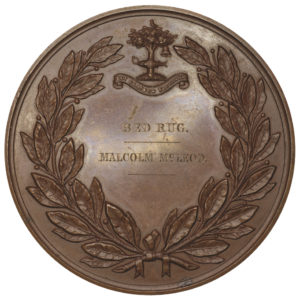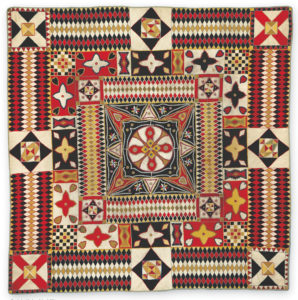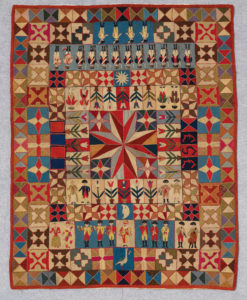
Fig. 1. Detail of the quilt in Fig. 13.
In 1986 the American Folk Art Museum accepted a quilt unlike any other in its already extensive collection. Comprised of concentric squares pieced from the tiniest bits of heavy felted wools in a severe palette of black, red, and cream, its dizzying geometric pattern and unwieldy fabric made the quilt antithetical to any with which we were familiar (Fig. 2). By 2008, when the museum was given a similarly constructed geometric quilt, we had come to recognize these works as important examples of a genre made exclusively by men, using richly dyed wools derived from British military uniforms associated primarily with the Crimean War but also with conflicts in India, South Africa, and other troubled regions of the British Empire during the nineteenth century (Fig. 3).

Fig. 2. Soldier’s quilt in the square-within-a-square pattern, Crimea, India, or United Kingdom, c. 1850–1880. Wool, probably from military uniforms; 86 by 66 inches. American Folk Art Museum, New York, gift of General Foods; photograph by Schecter Lee.
The first exhibition in the United States devoted to these textiles, made by sailors, soldiers, and military and civilian tailors, and once termed “convalescent” quilts, is on view this fall at the American Folk Art Museum, organized in collaboration with the International Quilt Study Center & Museum, University of Nebraska–Lincoln. War and Pieced: The Annette Gero Collection of Quilts from Military Fabrics will demonstrate that these spectacular mosaic pieces follow an earlier tradition of pictorial quilts dating from the Prussian and Napoleonic wars that were also made using felted materials, often from uniforms (Fig. 3).1 Gero is the internationally acclaimed quilt authority whose recent scholarship has ignited interest in these fascinating textiles, no two of which are exactly alike, and fewer than a hundred of which have been found in Australia, Canada, Europe, the United Kingdom, and the United States.
- Fig. 3. Soldier’s quilt, probably India, c. 1850–1880. Wool, probably from military uniforms, with hand embroidery, rickrack, velvet binding, and appliqués; 67 by 66 inches. Every seam is outlined in chain stitch, and rickrack is expertly applied around each concentric border framing the central medallion. Medallions and stars are further embellished with layers of elaborate appliqués, the fancy-cut edges of which suggest they were stamped using a special die or tool. American Folk Art Museum, gift of Altria Group, Inc.; photograph by Gavin Ashworth.
- Fig. 4. Anglo-Zulu War soldier’s quilt, South Africa or United Kingdom, late nineteenth century. Wool from military uniforms, with hand embroidery and pointed and pinked edges; 88 by 85 inches. This quilt with thousands of tiny diamond patches is entirely hand-sewn, using fabric salvaged from nineteenth-century military uniforms. A small inner square is embroidered with British crowns, flags, and anchors, but the majority of the embroidered motifs show African huts, spears, shields, and a drum—elements that suggest the quilt was made in commemoration of the Anglo-Zulu War, either on-site or after the soldier had returned home. The Anglo-Zulu War of 1879 was especially notable for its first major battle at Isandlwana, a British defeat that stunned the world. It was unthinkable that a “native” force, armed mostly with close-range stabbing weapons, could overwhelm the troops of a western power outfitted with modern rifles and artillery. Annette Gero Collection; photograph by Tim Connolly, Shoot Studios.
For years it was believed that most of the military quilts were made using material salvaged from the uniforms of fallen soldiers. In 1872 one soldier, Joseph Rawdon, wrote a letter describing a quilt that took “all of six years on and off to make . . . from different uniforms, more than a few pieces from poor fellows that fought hard for their country and fell in the struggle.”2 Despite this testimony, however, the organic detritus of war—blood, oil, and gun powder—has not yet been discovered on military quilts, though recent conservation of one revealed the use of recycled uniforms, evidenced by the presence of “old hemlines, stitch outlines left from jacket pockets, and even buttonholes.”3

Fig. 5. Prussian Army intarsia quilt by Samuel Sadlowski, Prussia, 1806. Wool from Napoleonicera military uniforms; 50 by 69 inches. Samuel Sadlowski was taken prisoner by the French while serving in the Prussian Army during the Napoleonic Wars. A tailor in civilian life, Sadlowski utilized his skills to sew officers’ uniforms during his internment. He created this and two additional quilts from leftover scraps of material. The initials “S.S.” on this quilt are his own, while “E.W.S.” are those of his wife, Eleanora Wilhelmina Schaar; also worked into the quilt is the date 1806. The double-headed eagle figures prominently in the centerpiece, flanked by golden thrush and cathedral sparrows. The quilt also includes a series of inlaid blocks that are particular to Prussian intarsias. Known as “fort blocks,” they may represent bird’s-eye views of eighteenth-century fortresses of the region, especially star forts. A border along the bottom is illustrated, surprisingly, with the folk tale of the fox and the goose; an embroidered lyric from a German children’s song translates as “Fox, you’ve stolen the goose.” Annette Gero Collection; Connolly, Shoot Studios photograph.
The visual virtuosity of military geometric quilts— often incorporating many thousands of pieces no larger than one-inch square—assumes a deeply emotional dimension as we consider them in the context of war and its aftermath. They have been most commonly identified with the Crimean War (1853–1856), an alliance of British, French, and Turkish forces united against Russian intrusion into the Ottoman Empire and the struggle for control of the Holy Land. It was the first war in history to be thoroughly documented in photography, as well as in firsthand accounts published by journalists and other civilian observers. The Crimean War revealed inherent weaknesses in the traditional British military system as it entered the modern age, even as it gave rise to the trope of the “compassionate” soldier in literature and the popular press.
- Fig. 6. Portrait of Private Thomas Walker by Thomas William Wood (active 1855–1872), 1856. Oil on canvas, 21 ¼ by 17 ¾ inches. Private Thomas Walker, of the 95th (Derbyshire) Regiment of Foot, sustained a serious head wound during the Crimean War. Sent home to England, over many months he underwent more than a dozen surgeries in the Fort Pitt military hospital to remove skull fragments. During periods of convalescence, he occupied himself by making quilts and rugs from military uniforms, a skill he apparently learned from another wounded soldier’s wife. Walker’s unusual case was celebrated in the newspapers. Queen Victoria visited him several times on her royal rounds through the military hospitals, and her interest extended to acquiring one of his quilts, as reported in the Morning Chronicle on December 25, 1855. On March 3, 1856, the Chronicle noted that artist Thomas Wood had been engaged to paint Walker’s portrait. By portraying Walker upright in a clean bed, well-tended, and usefully employed, the portrait acts as a rebuttal to the incriminations of ineptitude leveled against the military and government management of the war. Hunterian Museum—Royal College of Surgeons of England, London.
- Fig. 7. The Royal Fusilier’s Band-Boy and the Patchwork Quilt, illustration in the Band of Hope Review, no. 130 (October 2, 1871).
The men themselves wrote voluminous letters to friends and relatives detailing the incompetence of the military leadership, the carnage of soldiers and horses alike, and the challenge of everyday survival. For instance, Private Isaac Stephenson of the 4th Dragoon Guards wrote to a friend in Lancaster from Camp, Front Sevastopol, on January 3, 1855: “The weather here is both wet and cold, and we are still under canvass [sic] yet, with nothing to cover us at night only our blanket and cloak; and when we get up on a frosty morning, you would think that we had been sleeping in the open field; and, after all that has been done for us by the good people of England, we have received nothing but one flannel shirt, one pair of drawers, and one pair of socks: they are very slow in giving out those that are sent for us, but, never mind. I hope that I will be able to pull through all, with the help of God.”4

Fig. 8. Soldier’s intarsia quilt, India, 1860–1890s. Wool with braid, 60 inches square. Every seam in this stunning quilt—a riot of squares, diamonds, and triangles—is covered with a tiny strip of braid. Except for the braid, the back is identical to the front, as there are no seam allowances in the intarsia technique. The complexity of the design, technical virtuosity, and surface embellishment suggest that the quilt was made in India, probably by a British regimental tailor. Annette Gero Collection; Connolly, Shoot Studios photograph.
It seems almost inconceivable that uniform material was available for making quilts when the soldiers themselves suffered from such exposure—and complained of uniforms that were spattered with blood and dirt. As one soldier wrote, “Dear Brother, I can assure you that we are very near eaten up with filth and vermin. I have never had a clean article upon my back this two months.”5 Yet regiments might be immobile for weeks, even months, with little to do but get into mischief; and the cross-stitch inscription on one quilt testifies to its creation in the theater of war, before being sent home to a beloved sister.

Fig. 9. Regimental “bed rug” by Sergeant Malcolm Macleod, India, c. 1865. Wool, mostly from military uniforms, with hand embroidery; 95 by 63 inches. In 1865 Sergeant Malcolm Macleod entered his quilt in the Glasgow Industrial Exhibition, where it won a medal—as a “bed rug”—attesting to his exceptional workmanship and embroidery of such motifs as a Royal Navy sailor, a navy ship on a blue sea, and native Scottish thistles and foliage. Macleod was a member of the 72nd Duke of Albany’s Own Highlanders who fought with the Highland Brigade at the siege of Sevastopol in 1855 and were posted in central India during the Indian Rebellion (1857–1859). Though it may be hard to believe that Macleod made a quilt of this complexity while stationed in India, he stitched “E. Indies 1865” within the center square, along with his name and rank and the other regions where his regiment served. The yellow, red, white, and black diamond shapes are matched with an exactitude that one might describe as military precision. However, it is the embroidery in the yellow border that is truly extraordinary. It features foliate designs, urns overflowing with flowers, and the distinctive headwear with long, black feathers that was part of the regiment’s uniform. Annette Gero Collection; Connolly, Shoot Studios photograph.
In fact, however, the promotion of the soldier-quiltmaker was part of a calculated campaign throughout the United Kingdom to rehabilitate public opinion about the careless administration of the war and also to endorse quiltmaking as a masculine and healthful alternative to less savory activities among enlisted men, such as drinking and gambling. Illustrated articles in the popular press equated quiltmaking with the sentimental figure of the drummer boy, deflecting attention from the military elite (Fig. 7), and at the same time romanticizing the practice as occupational therapy for convalescing soldiers.6 According to a report in the March 3, 1856, issue of London’s Morning Chronicle, a portrait of Private Thomas Walker by the painter Thomas William Wood (Fig. 6) showed Walker “in bed, busily engaged sewing together pieces of different coloured cloth, for the purpose of making the quilt which the Queen, upon seeing, was pleased to order to be sent to the palace.”7 Walker was recovering from a devastating head wound sustained in the Battle of Inkerman, waged on November 5, 1854. In the portrait, his uniform lies atop the section of the quilt he has already completed, creating an immediate and visceral relationship between the material he is using and the devastation of war, inferred by the white cap covering his head wound and the abandoned headgear bearing the number of his regiment. Intended for public exhibition, the painting attempted to ameliorate the widely reported privations suffered by the soldiers by demonstrating the compassionate care bestowed on Private Walker in a veterans’ hospital. That said, there is little additional evidence that convalescing soldiers practiced quiltmaking, and the simple strip quilt that Private Walker is piecing is a far cry from the dazzling compositions made by regimental tailors and talented soldiers.
- Fig. 10. Medal won by Sergeant Malcolm Macleod at the Glasgow Industrial Exhibition 1865–1866. Bronze, diameter 2 inches. Cast into the obverse, “GLASGOW INDUSTRIAL EXHIBITION / 1865–66”; inscribed on the reverse is “BED RUG. / MALCOLM MCLEOD [sic].” Annette Gero Collection.
- Fig. 10a. Back of medal in Fig. 10.
Most of the geometric quilts are constructed from pieces of cloth that have been placed next to each other and joined with simple whipstitches, which could then be disguised with embroidery; some also include elaborate layered appliqués that were probably cut using a special stamp. The quilts often feature a center medallion— usually square or rectangular—surrounded by concentric frames and borders that provide opportunities for unique arrangements of triangles, diamonds, squares, and hexagons of various sizes (Fig. 8). The relationship between these patterns and woodworking techniques such as inlay, marquetry, and parquetry, practiced predominantly by men, seems undeniable. Pride of workmanship is also evident in both mediums, some of which survive with notes appended by makers that recite the numbers of pieces used and hours invested.
- Fig. 11. Beaded soldier’s quilt, India, c. 1860–1870. Fulled wool, with appliqués and beadwork, 63 inches square. India has an ancient history of beadmaking so it is perhaps not surprising that military quilts made during British rule often incorporated tiny glass beads and other colorful decorations. This quilt is a wonderful example of this technique, as the patchwork design is enhanced by myriad beads that are even attached over the seams of appliqués. Each bead is sewn on a miniscule circle of fabric, probably material cut away from uniforms to form buttonholes. Annette Gero Collection; Connolly, Shoot Studios photograph.
- Fig. 13. Intarsia quilt with soldiers and musicians, Prussian, c. 1760s–1780s. Wool, with embroidery and appliqués, 55 by 43 inches. The musicians, soldiers, and potted tulips that distinguish this intarsia quilt relate strongly to motifs seen in other Germanic folk arts, from textiles and ceramics to fraktur. The soldiers at the top wear the red, blue, and white uniforms of musketeers of a Prussian infantry regiment, and the soldiers in white are Prussian cuirassiers, the heavy cavalry regiments who wore uniforms of this kind in the period of Frederick the Great (1712–1786). The quilt also includes fort blocks and blocks that depict a court jester, couples, and a stork, the symbolic bringer of children. The quilt is initialed “J.S.J.,” but it is not known whether this is the maker or the person for whom the quilt was made. Annette Gero Collection; Connolly, Shoot Studios photograph.
Some of the most intricately designed quilts appear to derive from the British presence in India, which began in the seventeenth century with the formation of the East India Company. This enduring presence represented a considerably more stable situation in terms of housing and outfitting for the troops than the Crimean War, a campaign conceived as short-term and strategic. Off-cuts and scraps of uniform fabrics were available from civilian and regimental tailors and were often more colorful than those associated with the Crimean War. Many of the quilts made in India are also embellished with beads, spangles, trims, and embroidery, influenced perhaps by native Indian textiles and dress (Figs. 8, 11). A number reveal regimental emblems and even embroidered notations that indicate action seen by the regiment (Fig. 12).

Fig. 12. Soldier’s quilt, India, c. 1855 (pre-1881). Felted wools from military uniforms, with beading and hand- appliquéd border; 82 by 88 inches. This extraordinarily complex quilt features the crossed flags of the coat of arms of the 37th (North Hampshire) Regiment of Foot, which was stationed in India at various times beginning in 1846, and participated in the rebellion of 1857–1859. The brilliant mosaic of felted wools taken from uniforms also includes beadwork crowns and Prince of Wales plumes in the four corners of an inner border. In addition, the outer border is further appliquéd with heart, diamond, and flower motifs that have been cut by pinking (either by machine or with a special tool made for this purpose) and applied in concentric layers that result in an impressive three-dimensional effect. Annette Gero Collection; Connolly, Shoot Studios photograph.
The use of fulled or felted fabrics in quilts antedates the pieced geometric examples of the mid- to late nineteenth century, as seen in a tradition of narrative textiles dating to the Prussian and Napoleonic wars. From the early eighteenth century through the early nineteenth, professional tailors in Germanic Europe, as well as prisoners of the Napoleonic Wars, created pictorial quilts and panels employing a technically challenging technique known as intarsia. Because the fabric did not fray when cut, the pieces could be assembled with no seam allowances, using minute stitches to join the pieces into intricate pictorial panoplies, or inlaid into receiving shapes cut from the background material. The result in both cases was an uninterrupted surface that was the same on the front and the back, and the imagery was more fluid than even traditional appliqué. The characters contained in the scenes were based on popular types—soldiers, musicians, and public figures—and were often traced or copied from published prints (Fig. 13). The use of print sources persisted as the art of intarsia found its way to Victorian London, probably via immigrant tailors since the technique demanded such a high degree of skill (Figs. 14, 15).

Fig. 14. The Intellect and Valour of Great Britain intarsia quilt by Michael Zumpf (c. 1819–1891), London, with a floral border made in Bohemia, c. 1870. Wool from military and naval dress uniforms, with silk embroidery; 75 by 85 inches. The intarsia quilt-making technique may have migrated to England with skilled tailors, such as Hungarianborn Michael Zumpf, who produced at least two spectacular examples valued at £300 in the 1870s. Compared to the more familiar appliqué technique, intarsia allowed for finer details and an uninterrupted surface. The quilt is made of wools from military uniforms, including, judging by the brightness and variation of color, fabrics from regimental ceremonial uniforms. The outer borders are inlaid with brilliant, multicolored flowers and embroidered with colored silks. The central image is based on The Intellect and Valour of Great Britain, a print after a painting by English artist Thomas Jones Barker (Fig. 15). Annette Gero Collection; Connolly, Shoot Studios photograph.
British historian Holly Furneaux has identified opposing impulses in Victorian responses to war. On the one hand, she writes of pride in longstanding British military traditions and its structure based on a hierarchical system of social order rather than merit. On the other, she explores the emergence of the regular enlisted “military man of feeling,” whose heroism and compassion elevate him above his humble rank.8 Wartime quilts reconciled the conflict between the empathetic soldier and the one who plunders trophies from fallen enemy combatants. In the context of war, quiltmaking becomes an act of redemption for darker human impulses enacted under dire circumstances. Memory and experience are fragmented and brilliantly reconstructed through tiny bits of cloth. The uniforms, associated with the best and the worst of humanity, are thus transformed into testaments of ordered sanity and beauty, even as the highly organized geometry grants the soldier an illusion of control over the predations of war he has both witnessed and participated in.

Fig. 15. The Intellect and Valour of Great Britain, 1863, engraved by Charles G. Lewis (1808–1880) after a painting by Thomas Jones Barker (1815–1882), published by John Garle Browne, Botcheston, Leicester, England, 1864. Mixed method engraving, 42 ¾ by 28 ¾ inches. It is thought that the print served as the actual pattern for the scene in the quilt, as all the pictorial elements are the same size in both. Each person has been identified, including Benjamin Disraeli and William Gladstone, among other important English soldiers, statesmen, and writers of the period. Annette Gero Collection.
War and Pieced: The Annette Gero Collection of Quilts from Military Fabrics will be on view at the American Folk Art Museum from September 6 through January 7, 2018, and at the International Quilt Study Center & Museum, University of Lincoln–Nebraska from May 25 to September 16, 2018. The related book, Wartime Quilts: Appliqués and Geometric Masterpieces from Military Fabrics by Annette Gero (Beagle Press, 2015), is available in the United States through the American Folk Art Museum Shop.
1 In 2009–2010 these rare textiles were the subject of Inlaid Patchwork in Europe from 1500 to the Present, an exhibition at the Museum Europäischer Kulturen, Berlin, curated by Dagmar Neuland- Kitzerow, and Salwa Joram. 2 Quoted in Holly Furneaux and Sue Prichard, “Contested Objects: Curating Soldier Art,” Museum and Society, vol. 13, no. 4 (November 2015), p. 447, accessed online November 1, 2016. 3 Zenzie Tinker Conservation, “Crimean War Quilt,” zenzietinker.co.uk, accessed April 24, 2017. 4 Quoted in Anthony Dawson, Letters from the Light Brigade: The British Cavalry in the Crimean War (Pen and Sword, South Yorkshire, England, 2014),p. 120. 5 Ibid, p. 109. 6 This popularization of the trope of the convalescing soldier as quiltmaker gave rise to the nomenclature “convalescent quilt” when referring to these distinctive textiles. It now appears unlikely that any but the simplest geometric strip piecework was possible under hospital conditions. 7 “Private Thomas Walker, by Thomas Wood,” trc-leiden.nl, accessed November 1, 2016. 8 Holly Furneaux, Military Men of Feeling: Emotion, Touch, and Masculinity in the Crimean War (Oxford University Press, Oxford, 2016).
Stacy C. Hollander is the deputy director for curatorial affairs and the chief curator/director of exhibitions at the American Folk Art Museum. She recently received two first-place awards for excellence from the Association of Art Museum Curators and the AAMC Foundation for her 2016 exhibition Securing the Shadow: Posthumous Portraiture in America.
Annette Gero, a collector, author, exhibition curator, and museum adviser, is an elected Fellow of the Royal Society for the Encouragement of Arts, Manufactures and Commerce (RSA) in recognition of her work on quilt history. She is one of Australia’s leading quilt historians.

